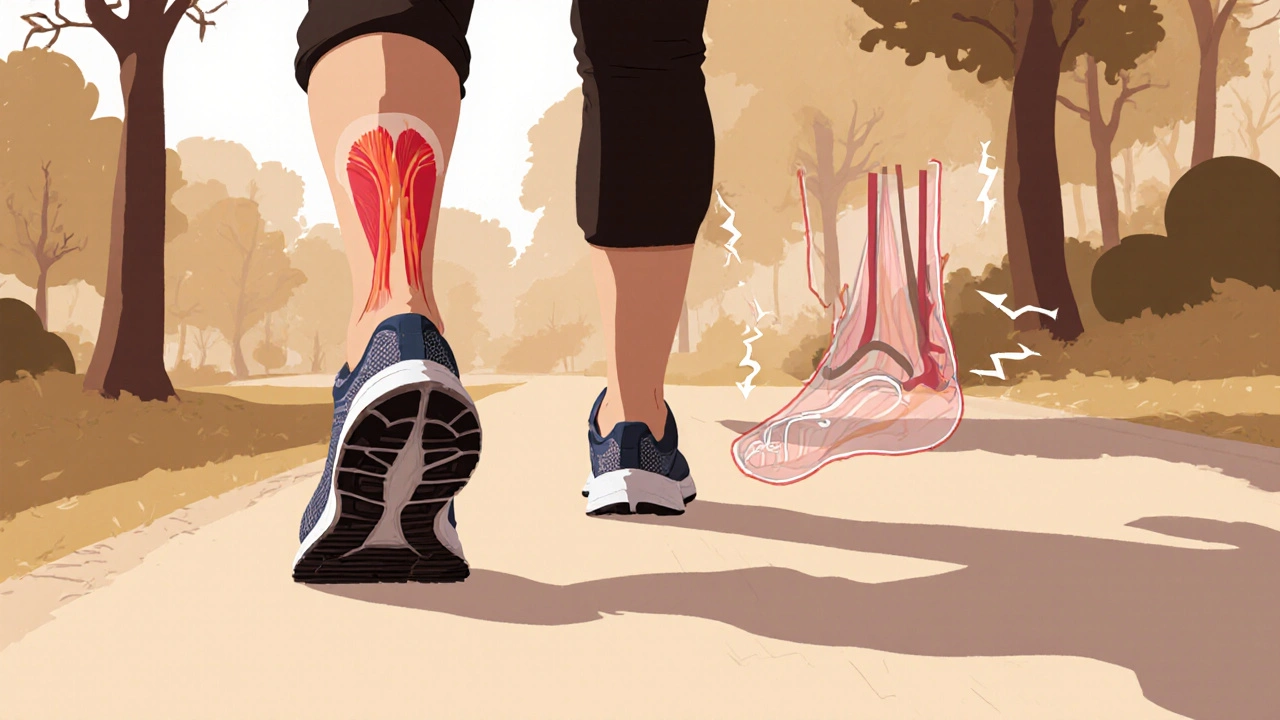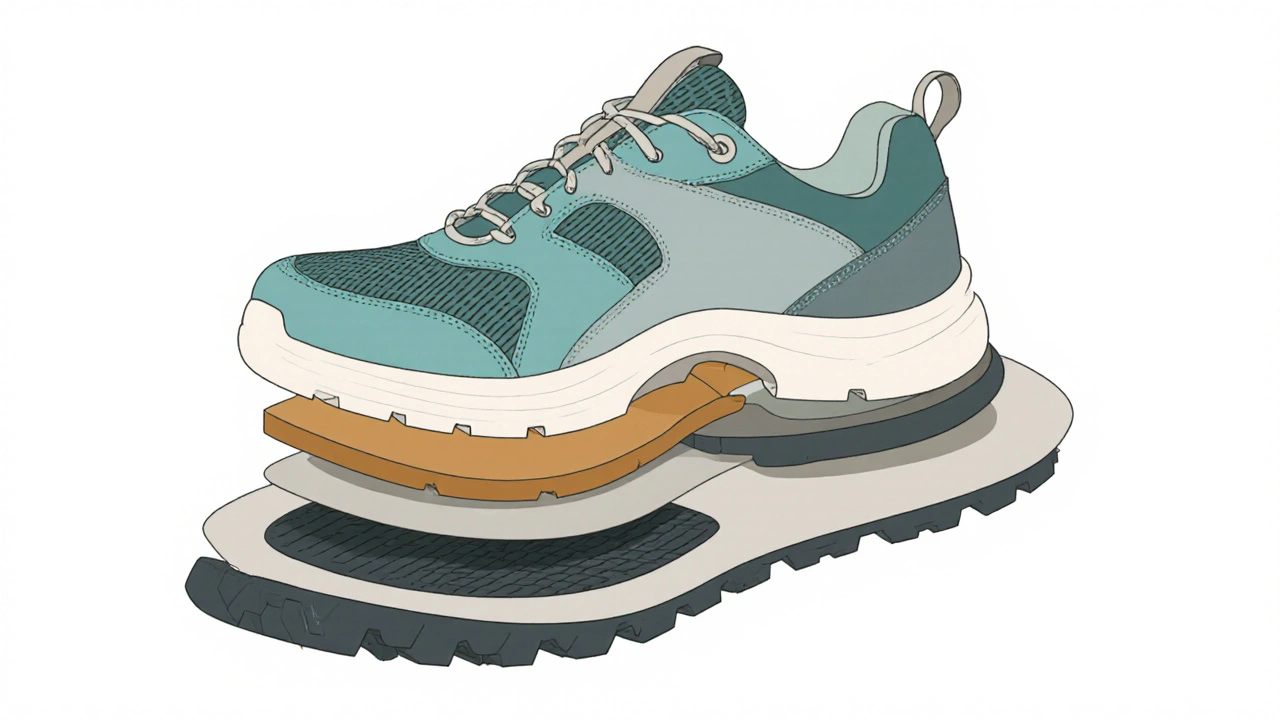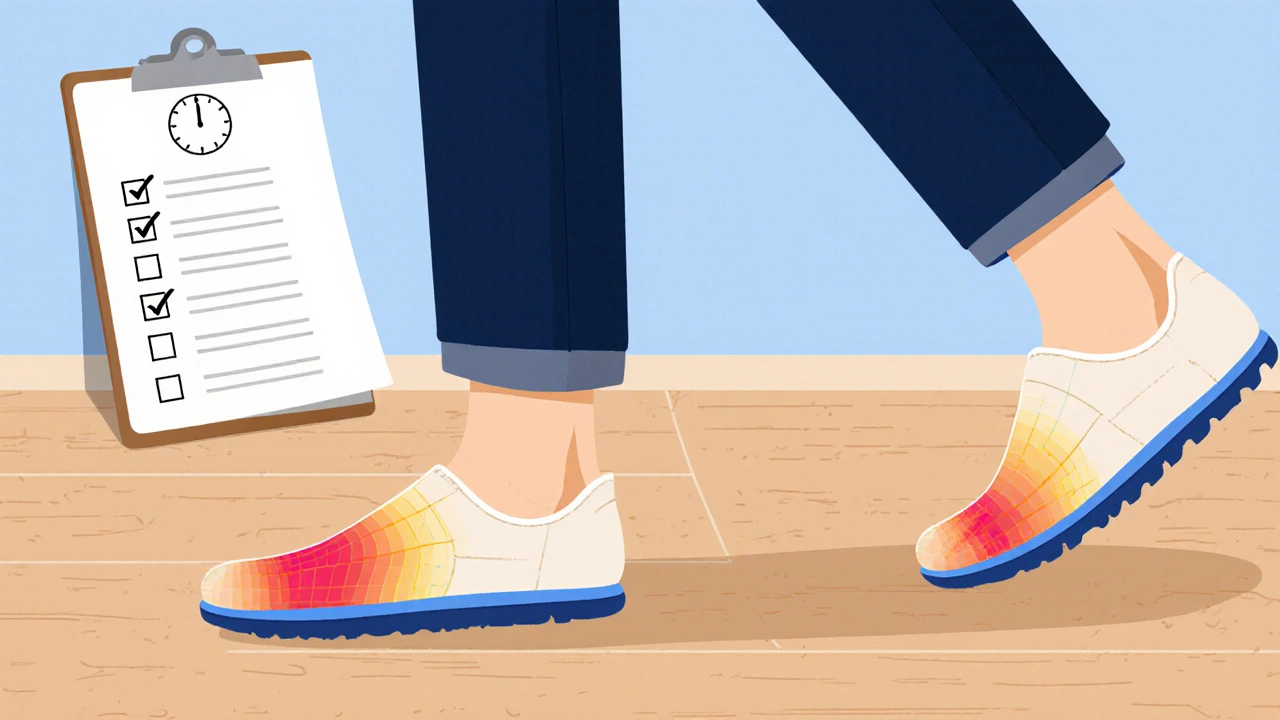Choosing the Best Shoes for Intermittent Claudication Relief

Shoe Feature Calculator for Claudication Relief
Personalized Shoe Recommendations
Quick Takeaways
- Pick shoes with firm heel cushioning and reliable arch support.
- Look for breathable uppers and a modest heel‑to‑toe drop (5‑12 mm).
- Get your size measured while wearing any orthotic or compression sock you use.
- Test shoes on a short walk; pain should stay under 2 minutes of walking.
- Replace shoes every 6‑12 months, or sooner if the outsole wears down.
Living with Intermittent Claudication is a daily reminder that your legs aren’t getting enough blood when you walk. The pain usually shows up in the calves, thighs, or buttocks, and it can make a simple stroll feel like a marathon. One of the easiest, cost‑effective ways to soften those attacks is to wear the right pair of shoes. Below is a step‑by‑step guide that walks you through the science, the features to hunt for, and the practical tips to make sure the shoes you buy actually help.
What Intermittent Claudication Is and Why Shoes Matter
In most cases, Intermittent Claudication is a symptom of Peripheral Artery Disease (PAD). The narrowed arteries can’t deliver enough oxygen‑rich blood when the muscles work harder, so they start to ache. The pain usually eases after a brief rest, but the cycle repeats each time you try to move.
When you walk, the muscles in your calves and thighs contract repeatedly. Each contraction needs a surge of blood. If the shoes you wear are too soft, they let your foot slap the ground, forcing extra muscle work just to stabilize yourself. That extra work makes the oxygen demand even higher, worsening claudication. Conversely, shoes that give a stable platform, cushion the heel, and support the arch reduce unnecessary muscle effort, letting the limited blood supply go where it’s most needed.
Key Shoe Features That Keep Pain in Check
Think of a good pair of walking shoes as a tiny, mobile orthopedist. The following features are the most predictive of pain reduction for people with claudication:
- Heel Cushion: A dense, yet responsive cushion (often EVA or PU) absorbs impact on each step. Look for a heel stack height of 15‑25 mm.
- Arch Support: A firm mid‑sole arch helps keep the foot from rolling inward (overpronation), which can make calf muscles work harder.
- Moderate Heel‑to‑Toe Drop: A drop of 5‑12 mm gives enough heel lift to reduce calf strain without compromising natural gait.
- Breathable Upper: Mesh or engineered knit keeps feet cool, preventing swelling that can further narrow blood flow.
- Stable Outsole: A rubber outsole with a wide, flat base improves balance and distributes pressure evenly.
- Room for Orthotics or Compression Socks: If you already use a custom Orthopedic Insole or Compression Socks, make sure the shoe’s interior volume can accommodate them without tightness.
How to Measure Your Feet for the Best Fit
Getting the right size is more than just reading the label on the box. Follow these steps:
- Put on the socks you’ll normally wear for walking (including any compression socks).
- Stand on a piece of paper, trace the outline of each foot, then measure the longest distance (heel to toe) and the widest part (ball of foot).
- Compare your measurements to the brand’s size chart; add a half size if the ball of foot measurement falls between two sizes.
- Check the toe box: you should be able to wiggle your toes comfortably. A cramped toe box forces the forefoot to work harder.
- Walk around the store for at least five minutes. If you notice any new pain, stop-those shoes aren’t right for you.
Many clinics also perform a quick Ankle‑Brachial Index (ABI) test to gauge the severity of PAD. Knowing your ABI can help you decide how aggressive you need to be with footwear and other therapies.

Top Shoe Recommendations (2025 Models)
Below are three categories that cover most budgets and preferences. All of them meet the feature checklist above.
- Traditional Support - Example: WalkGuard 7: 28 mm heel cushion, built‑in arch shell, 9 mm drop, full‑grain leather upper with breathable perforations. Ideal for those who want a classic look.
- Lightweight Performance - Example: AeroStride Lite: 22 mm EVA heel, adaptive mesh upper, 6 mm drop, removable arch insert. Good for active walkers who still need support.
- Orthopedic‑Focused - Example: MedFit CustomFit: Comes with a pre‑shaped Orthopedic Insole, 25 mm heel cushion, 12 mm drop, extra‑wide toe box. Best for severe claudication or those already using orthotics.
When you shop online, look for a 30‑day return policy so you can test the shoes at home. The best pair will feel supportive from the first step, not just after a break‑in period.
How to Test Shoes Before You Commit
Even with all the specs, real‑world testing is essential. Here’s a quick protocol you can run at home:
- Put on the shoes with your regular walking socks.
- Walk on a flat, indoor surface for three minutes at a comfortable pace.
- Note any calf, thigh, or buttock pain. If pain starts before two minutes, try a different model.
- Pay attention to gait feel: your steps should feel stable, not wobbly.
- After the walk, check the inside of the shoe for any red marks-these indicate pressure points.
If you have access to a gait‑analysis lab, ask for a short assessment. Professionals can point out whether the shoe is encouraging overpronation or an uneven stride, both of which can exacerbate claudication.
Comparison Table: Feature Snapshot
| Feature | WalkGuard 7 | AeroStride Lite | MedFit CustomFit |
|---|---|---|---|
| Heel Cushion (mm) | 28 | 22 | 25 |
| Arch Support | Rigid Shell | Adaptive | Custom Insole |
| Drop (mm) | 9 | 6 | 12 |
| Upper Material | Leather + Perforations | Engineered Mesh | Soft Knit |
| Weight (g) | 340 | 280 | 355 |
| Price (USD) | 120 | 140 | 180 |

Common Mistakes and How to Avoid Them
- Choosing the lightest shoe by default: Ultra‑light shoes often lack the heel cushion needed for claudication.
- Ignoring toe‑box width: A narrow toe box forces the foot to work harder, increasing calf strain.
- Skipping the break‑in period: Even the best shoes need a few short walks to settle.
- Wearing the wrong sock: Thick, non‑breathable socks can cause swelling; opt for moisture‑wicking or compression varieties.
- Forgetting to replace worn shoes: Outsole wear reduces stability; replace when the tread depth falls below 3 mm.
Checklist: Is Your Shoe Ready for Claudication?
- Heel cushion ≥ 15 mm?
- Arch support firm enough to prevent overpronation?
- Heel‑to‑toe drop between 5‑12 mm?
- Breathable upper & adequate toe box?
- Fits with any orthotics or compression socks?
- Passed the three‑minute home test with < 2 minutes of pain?
- Outsole tread still deep enough?
Next Steps for a Pain‑Free Walk
Once you have the right pair, combine them with a regular walking program and a heart‑healthy lifestyle. Many doctors recommend a supervised walking regimen-start with five minutes, add a minute each day, and aim for 30 minutes most days. Pair that with smoking cessation, cholesterol control, and blood‑pressure management, and you’ll see the claudication symptoms ease over weeks.
If pain persists despite optimal shoes and exercise, return to your vascular specialist. Sometimes revascularization procedures are needed, but good footwear is always the first line of defense.
Can I use regular running shoes for intermittent claudication?
Regular running shoes often have a high drop and a very flexible sole, which can increase calf muscle work. Look for shoes that offer a firm heel cushion, modest drop, and built‑in arch support-features not always present in typical running models.
How often should I replace my walking shoes?
Most experts suggest every 6‑12 months, or sooner if the outsole tread drops below 3 mm or you notice a loss of cushioning during your home test.
Do compression socks help when wearing supportive shoes?
Yes. Compression socks improve venous return and can reduce swelling, making the foot fit more comfortably inside a supportive shoe. Just ensure the shoe’s toe box isn’t too tight.
Should I get custom orthotics for claudication?
If you have severe overpronation or foot deformities, custom orthotics can further off‑load the calf muscles. Choose shoes with removable insoles so the orthotic fits securely.
What’s the difference between heel‑to‑toe drop and heel height?
Heel height is the total thickness of the heel cushioning. Drop is the difference in height between the heel and the forefoot. A moderate drop (5‑12 mm) reduces calf strain while still allowing a natural foot roll.

Sarah Hanson
October 18, 2025 AT 21:30Thank you for the thorough guide; the emphasiss on heel cushioning and arch support aligns precisely with clinical recommendationz.
Nhasala Joshi
October 30, 2025 AT 10:16Wow, this is exactly what the hidden elite don’t want you to know! They’re pushing ultra‑light shoes to make us exert more calf muscle work while they profit from our pain 😱💥 The heel‑to‑toe drop conspiracy is real; the higher the drop the more strain on your circulation. Stick to the moderate drop range, or the "big pharma" of footwear will keep you walking in misery. 🙄🚶♀️
Poornima Ganesan
November 11, 2025 AT 00:03The article nails the biomechanics behind claudication and footwear, but let me expand on why each feature matters. First, a dense heel cushion reduces the peak ground reaction force, which otherwise forces the calf muscles to work harder just to stabilize each step. Second, firm arch support prevents excessive pronation, a motion that increases the metabolic demand of the posterior compartment. Third, the moderate heel‑to‑toe drop maintains a natural gait angle while keeping the gastrocnemius from over‑contracting. Fourth, breathable uppers do more than keep feet dry; they reduce edema that can further restrict arterial inflow. Fifth, a wide, flat outsole distributes pressure evenly, sparing the plantar fascia and forefoot muscles.
When you actually measure your feet with socks on, you’ll notice that many commercial size charts ignore the added volume of compression garments. Adding a half size in such cases is not just a suggestion, it’s a necessity for maintaining proper alignment. The toe box width is another often‑overlooked factor; a cramped toe box forces the forefoot into valgus, which can cascade up the kinetic chain and add strain to the tibialis posterior.
Consider the material of the mid‑sole: EVA is lightweight but may compress too quickly, whereas PU retains its resilience longer, offering consistent support over the shoe’s lifespan. If you’re using custom orthotics, the shoe must have a removable insole; otherwise you’ll end up with a double‑layer that creates pressure points.
Take the three‑minute home test seriously. If you feel any calf ache before the two‑minute mark, the shoe is either too soft or the drop is too high. In my experience, the “lightweight performance” category often sacrifices heel cushioning for weight savings, which can be a deal‑breaker for claudicants.
Finally, don’t ignore the wear pattern on the outsole. Uneven wear indicates imbalance and may signal that the shoe is no longer providing the stable platform you need. Replacing shoes every six months is a good rule of thumb, especially if you notice the tread depth falling below three millimeters.
In summary, the right shoe is a blend of cushioning, support, breathability, and durability, all tuned to your specific vascular and biomechanical needs.
Emma Williams
November 22, 2025 AT 13:50The checklist at the end is spot on.
Albert Fernàndez Chacón
December 4, 2025 AT 03:36Great points on toe box width and orthotic compatibility. I’ve tried a few models and those with a removable insole make swapping in a custom footbed painless. The three‑minute test really helped me weed out a pair that felt soft but turned out to be too compressible after a short walk. Keep it simple and stick to the basics – heel cushion, arch, and proper fit.
Drew Waggoner
December 15, 2025 AT 17:23Honestly, the drama around "conspiracies" is exhausting. The core issue is still the same: shoes that don’t provide enough support force your calves to work harder, making the pain worse. I prefer a straightforward approach – pick a shoe with solid heel cushioning and avoid the hype.
Mike Hamilton
December 27, 2025 AT 07:10It is interesting how we often overlook the philosophical dimension of something as mundane as footwear. In a way, the shoe becomes an extension of our body’s intention to move forward despite obstacles. If we think of the shoe as a partner rather than a tool, we start to appreciate the subtle balance between support and freedom. This mindset shift can actually reduce the mental stress associated with claudication, which in turn may have a modest effect on vascular tone. So, choose a shoe that feels like a trusted companion, not just a piece of equipment.